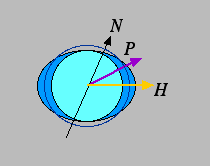 Fourier Analysis of Ocean Tides I
Fourier Analysis of Ocean Tides I
4. The trigonometry of the solar tide
With the notation and assumptions from the previous
page, P is a point on the Earth, H is the direction
of the Sun and, as a function of time,
A(t) = angle between H and P =
arccos LC{cos Tt, cos [T+2h]t, sin ht}.

|
The dark blue circle represents the ideally spherical surface
of the Earth's ocean;
the solid blue ellipse shows the result of tidal stretching.
The height of the ellipse above the spherical surface, at P,
is proportional to
the vertical component of the solar tide-producing force at P.
|
The Sun's gravitational field, since it stretches matter in the
direction of the Sun, will deform the ideally spherical surface of the
Earth's oceans into an ellipsoid of revolution,
with major axis pointing towards
the Sun. For the volume of the oceans to remain constant, the surface
of this ellipsoid must lie alternately above and below the spherical
surface. Let us define the ``solar tide-producing force" F at any point to
be the vertical distance from the spherical surface to the stretched
one. The figure shows that distance to be proportional to
cos 2A(t), i.e. at a maximum when A(t) = 0o
or A(t) = 180o: when the Sun is straight up
or straight down.
Using the expression we have for A(t), this gives
F proportional to cos (2 arccos LC{cos Tt, cos [T+2h]t, sin ht}). The identity cos (2 arccos x) = 2 x2 -1 yields:
F = LC{ 1, (LC{cos Tt, cos[T+2h]t, sin ht})2}
= LC{ 1, cos2Tt, cos2[T+2h]t, sin2ht, cos Tt cos[T+2h]t, cos Tt sin ht,
cos[T+2h]t sin ht}.
A vigorous application of the trigonometric identities
- cos2x = (1+cos 2x)/2
- sin2x = (1-cos 2x)/2
- cos x cos y = (cos[x+y] + cos[x-y])/2
- sin x cos y = (sin[x+y] + sin[x-y])/2
leads to:
F = LC{1, cos 2Tt, cos[2T+4h]t, cos 2ht, cos[2T+2h]t,
sin[T+h]t, sin[T-h]t, sin[T+3h]t}.
|
The solar tide-producing force at a point P
is, as a function of time, a finite
linear combination of cosines and sines, whose
speeds are certain integral linear combinations of T and h.
|
The coefficients depend on the latitude of P.

 Fourier Analysis of Ocean Tides I
Fourier Analysis of Ocean Tides I